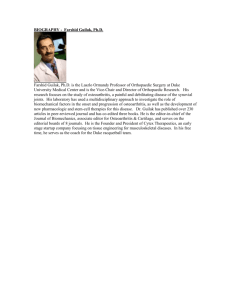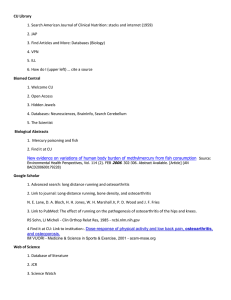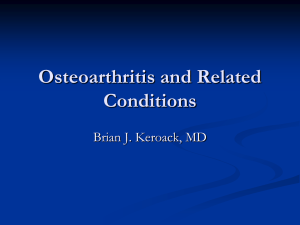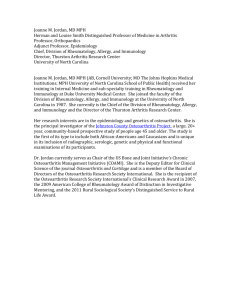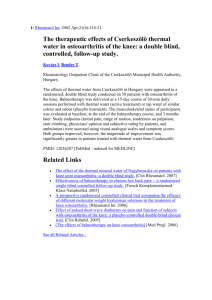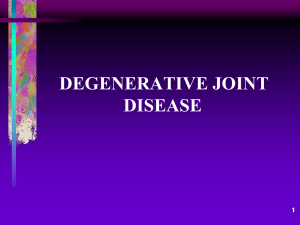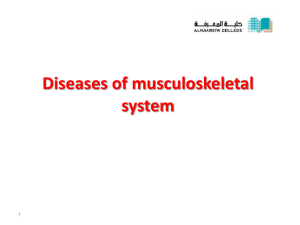Document 10464766
advertisement
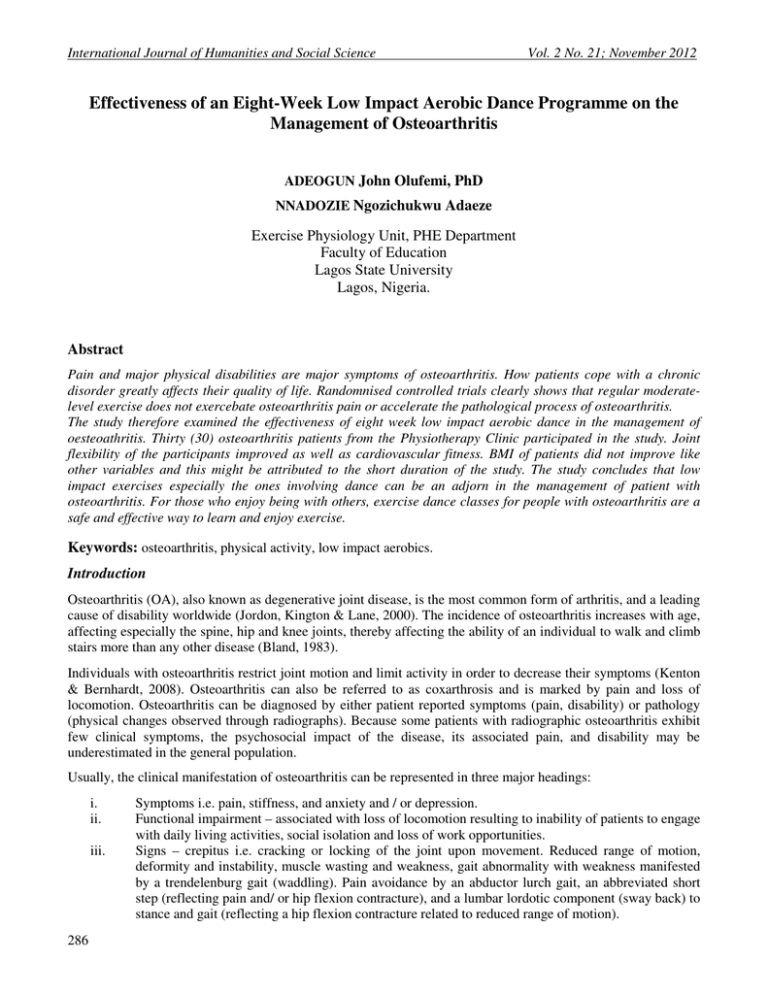
International Journal of Humanities and Social Science Vol. 2 No. 21; November 2012 Effectiveness of an Eight-Week Low Impact Aerobic Dance Programme on the Management of Osteoarthritis ADEOGUN John Olufemi, PhD NNADOZIE Ngozichukwu Adaeze Exercise Physiology Unit, PHE Department Faculty of Education Lagos State University Lagos, Nigeria. Abstract Pain and major physical disabilities are major symptoms of osteoarthritis. How patients cope with a chronic disorder greatly affects their quality of life. Randomnised controlled trials clearly shows that regular moderatelevel exercise does not exercebate osteoarthritis pain or accelerate the pathological process of osteoarthritis. The study therefore examined the effectiveness of eight week low impact aerobic dance in the management of oesteoathritis. Thirty (30) osteoarthritis patients from the Physiotherapy Clinic participated in the study. Joint flexibility of the participants improved as well as cardiovascular fitness. BMI of patients did not improve like other variables and this might be attributed to the short duration of the study. The study concludes that low impact exercises especially the ones involving dance can be an adjorn in the management of patient with osteoarthritis. For those who enjoy being with others, exercise dance classes for people with osteoarthritis are a safe and effective way to learn and enjoy exercise. Keywords: osteoarthritis, physical activity, low impact aerobics. Introduction Osteoarthritis (OA), also known as degenerative joint disease, is the most common form of arthritis, and a leading cause of disability worldwide (Jordon, Kington & Lane, 2000). The incidence of osteoarthritis increases with age, affecting especially the spine, hip and knee joints, thereby affecting the ability of an individual to walk and climb stairs more than any other disease (Bland, 1983). Individuals with osteoarthritis restrict joint motion and limit activity in order to decrease their symptoms (Kenton & Bernhardt, 2008). Osteoarthritis can also be referred to as coxarthrosis and is marked by pain and loss of locomotion. Osteoarthritis can be diagnosed by either patient reported symptoms (pain, disability) or pathology (physical changes observed through radiographs). Because some patients with radiographic osteoarthritis exhibit few clinical symptoms, the psychosocial impact of the disease, its associated pain, and disability may be underestimated in the general population. Usually, the clinical manifestation of osteoarthritis can be represented in three major headings: i. ii. iii. 286 Symptoms i.e. pain, stiffness, and anxiety and / or depression. Functional impairment – associated with loss of locomotion resulting to inability of patients to engage with daily living activities, social isolation and loss of work opportunities. Signs – crepitus i.e. cracking or locking of the joint upon movement. Reduced range of motion, deformity and instability, muscle wasting and weakness, gait abnormality with weakness manifested by a trendelenburg gait (waddling). Pain avoidance by an abductor lurch gait, an abbreviated short step (reflecting pain and/ or hip flexion contracture), and a lumbar lordotic component (sway back) to stance and gait (reflecting a hip flexion contracture related to reduced range of motion). © Centre for Promoting Ideas, USA www.ijhssnet.com Conservative medical treatment of OA has been directed at improving functional status through reducing joint pain and inflammation and maintaining or restoring joint function (Kenton & Bernhardt, 2008). Physical activity is essential to optimizing both physical and mental health and can play a vital role in the management of arthritis. Regular physical activity can keep the muscle around affected joints strong, decrease bone loss, and may help control swelling and pain. Regular activity replenishes lubrication to the cartilage of the joints and reduces stiffness and pain (Anderson, Blair, Cheskin, & Bartlett, 1997). Exercise also helps to enhance energy and stamina by decreasing fatigue and improving sleep. Exercise can enhance weight loss and promote long term weight management in those with arthritis who are overweight (Minor, 1999). Summarily, exercise is proven to improve general health and mood, reduce disability and fatigue, and to favorably modify risk factors in disease progression. Studies suggest that moderate intensity activity may improve pain, reduce disability, improve fitness and enhance psychological well being (US Dept, 1996; Van Baar, 1998 and Bautch, 1997). Therefore, helping individuals recognize that “regular exercise” includes a wide range of activities from gardening and using the stairs to more traditional vigorous exercise such as aerobic dance or running may make physical activity more appealing and achievable to a wider range of people. Increased physical activity has both immediate and positive benefits and if the full benefit of exercise is to be achieved, efforts must be made to have a well designed exercise programme. This study was therefore designed to examine effectiveness of an 8-weeks low impact aerobic dance on the management of osteoarthritis. Methods and Materials The population for this study comprised all osteoarthritis patients attending physiotherapy clinical sessions in the physiotherapy clinic, Lagos University Teaching Hospital, Idi-Araba, Lagos. The purposive sampling technique was used to select Thirty (30) osteoarthritis patients from the Physiotherapy Clinic. The criteria for inclusion as a participant for the study included: The person was diagnosed with osteoarthritis for more than 5years duration, was above 20 years of age and possed a comprehensive medical record stating cardiovascular status. The instruments used to determine and measure the variables in the study were: a) Visual Analog Scale – This was used to determine the intensity of a patient’s pain. A patient’s response to pain was plotted on a 10cm scale and calibrated from 0 – 10, where 0 represents no pain and 10 represents maximum pain. b) Muscle Grading system – This was used to determine and assess the strength of a given muscle or group of muscles. The grade value range from 0 representing no contraction palpated to 5 representing normal, complete range of motion (ROM) against gravity with maximal resistance. c) Goniometer – This was used to measure (in degrees) the amount of motion available at the hip and knee joints. The bicycle ergometer was the exercise modality, Aneroid sphygmomanometer was also used to determine blood pressure. All measurements were taken by the researchers under the same conditions to ensure intra-rater consistency. The descriptive statistics of mean, range and standard deviation were used in presenting results while the Inferential statistics of PPMCC and t-test were used for data analyses. Ethical Considerations. All measurements were conducted in strict privacy where the participants were neither heard not seen by other people. The nature of the study had earlier been explained to each participant before obtaining consent from them. Only those who voluntered took part in the study and data collected during the study were kept confidential. Results Table 1: Mean, Standard Deviation and Range results on patients’ age, weight and height. Characteristics Age (yrs) Weight ( kg) Height ( m) No 30 30 30 X 59.07 74.33 1.63 Sd 11.65 15.06 0.10 R 24.0-86.0 41.0-115.0 1.44-1.95 287 International Journal of Humanities and Social Science Vol. 2 No. 21; November 2012 Table 1 shows that the mean age of the patients was 59.07+11.65 within the range of 24 to 86 years. The mean weight of the patients was 74.33+15.06 within the range of 41 to 115 kg, and their mean height was 1.63+0.10 within the range of 1.44 to 1.95m. Table 2: Mean, Standard Deviation and Range results on patients’ systolic and diastolic blood pressure. Characteristics Systolic BP( mmHg) Diastolic BP( mmHg) No 30 30 X 127.93 80.00 Sd 12.14 5.87 R 110.0-160.0 70.0-90.0 Table 2 shows the mean systolic blood pressure of the patients was 127.93+12.14 within the range of 110 to 160mmHg and the mean diastolic blood pressure was 80.00+5.87 within the range of 70 to 90 mmHg. Table 3: Mean, Standard Deviation and Range results on patients’ Visual Analog Scale (VAS), Resting heart rate and Exercising heart rate. Characteristics VAS Resting HR Exercising HR No 30 30 30 X 7.17 76.53 76.40 Sd 1.39 9.82 8.75 R 5.0-10.0 62.0-100.0 64.0-100.0 Table 3 shows that the mean VAS for patients’ was 7.17+1.39 within the range 5 to 10. The table also shows the mean resting heart rate was 76.53+9.82 within the range 62 to 100 and the mean exercising heart rate was 76.40+8.75 within the range 64 to 100. Table 4: Mean , standard deviation and range on patients’ hip and waist girth. Characteristics Hip Girth Waist Girth No 30 30 X 41.23 38.75 Sd 3.77 4.55 R 31.5-48.0 30.0-46.5 Table 4 shows the mean hip girth of patients’ in the study was 41.23+3.77 within the range of 31.5 to 48 and the mean waist girth was 38.75+4.55 within the range of 30 to 46.5. Table 5: t-test result on aerobic dance and pain associated with osteoarthritis Variables Pretest (pain levels) Posttest (pain level) X 7.17 15.50 SD 1.39 8.80 X-Diff. SD-Diff. df t P -8.33 9.03 29 5.06 **0.001 The table shows that the pretest osteoarthritis pain of the patients had a mean value of 7.17±1.39, while the posttest recorded a mean value of 15.50±8.80. The mean difference was -8.33±9.03 with t-value of 5.06 [P<0.001].It therefore revealed that eight weeks aerobics dance have significant effect on the level of pain associated with osteoarthritis. Table 6: t–test result on Aerobics dance and Cardiovascular fitness of Osteoarthritis patients. Variables Pretest ( max VO2) Posttest (max VO2) X 38.72 43.47 SD 6.59 4.88 X-Diff -5.23 SD-Diff 1.71 Df 29 t 4.03 P **0.001 The table shows that the pretest mean value of Cardiovascular fitness of osteoarthritis patients was 38.72±6.59 while the posttest recorded a mean value of 43.47±4.88. The mean difference was -5.23±1.71 with a t-value of 4.03[p<0.001]. This shows that eight weeks aerobics dance have a significant effect on cardiovascular fitness of Osteoarthritis patients. 288 © Centre for Promoting Ideas, USA www.ijhssnet.com Table 7: t-test result of aerobics dance and knee flexibility of osteoarthritis patients Variables Pretest (knee flexibility) Post test(knee flexibility) X 85.71 88.84 SD 9.72 8.14 X-diff -3.13 SD-diff 7.96 Df 29 T 2.16 P *0.04 The pretest results for knee flexibility show a mean value of 85.71±9.72 while the post test results for knee flexibility shows a mean value of 88.84±8.14. The mean difference was -3.13±7.96 with a t-value of 2.16[ p<0.04]. Hence, eight weeks aerobics dance have a significant effect on knee flexibility of patients with osteoarthritis. Table 8: t-test result of aerobics dance and hip flexibility of patients with osteoarthritis Variables Pretest(hip flexibility) Posttest (hip flexibity) X 56.21 58.00 SD 6.10 6.76 X-diff -1.79 SD-diff 3.33 df 29 T 2.95 P **0.006 The pretest result on hip flexibility with osteoarthritis patients engaged in the aerobics dance had a mean value of 56.21±6.10 while the post test result was 58.00±6.76. The mean difference was -1.79±3.33 with a t-value of 2.95[p<0.006]. Based on the above results, the eight weeks aerobics dance have a significant effect on hip flexibility of patients with osteoarthritis. Table 9: t-test result of aerobics dance and trunk flexibility of patients with osteoarthritis Variables Pretest [trunk flexibility] Posttest[trunk flexibility] X 2.71 2.94 SD 0.74 0.70 X-diff -0.23 SD-diff 0.58 df 29 T 2.16 P *0.039 The pretest result on trunk flexibility among this group of patients had a mean value of 2.71±0.74 while the post test results showed a mean value of 2.94±0.70. the mean difference was -0.23±0.58 with a t-value of 2.16[p<0.039].Thus, the eight weeks aerobics dance have a significant effect on trunk flexibility of patients with osteoarthritis. Table 10: t-test result on aerobics dance and Body Mass Index of Patients with Osteoarthritis Variables Pretest [BMI] Post test [BMI] X 27.97 34.37 SD 3.91 35.87 X-diff -6.39 SD-diff 36.80 df 29 T 0.95 P 0.349 The pretest results show a mean value of 27.97±3.91 while the post test recorded a mean value of 34.37±35.87. the mean difference was -6.39±36.80 with a t-value of 0.95[p<0.349].The above revealed that eight weeks aerobics dance will have no significant effect on Body Mass Index of osteoarthritis patients. Discussion This study investigated the effectiveness of an eight week aerobics dance on the management of patients with osteoarthritis. Selected variables of physical fitness and symptoms of the condition osteoarthritis employed during the study included; level of pain, cardiovascular fitness, knee flexibility, hip flexibility, trunk flexibility, sex of participants and Body mass index (BMI). This study showed that the level of pain of patients with osteoarthritis improved tremendously with the aerobics dance classes for a duration of 8 weeks. The pain measuring parameter which is the visual analog scale recorded a reduction of the level of pain experienced by most participants in the aerobics dance class. This study is in line with Minor[1989] whose study on aerobic walking and aquatic exercises among people with osteoarthritis pain experienced improved conditions over a 3weeks and 12 weeks period for about 30 minutes in each duration of activity respectively. Pain which is usually a limiting factor for people suffering from osteoarthritis is the reason why patients seek medical attention [Bland 1989, and Dieppe 1994]. 289 International Journal of Humanities and Social Science Vol. 2 No. 21; November 2012 With moderate sports activity exposure i.e. non competitive leisure activities some studies have also shown an improve state of level of pain in osteoarthritis [ Kujala, Kapito & Sama 1994]. This study also found significant improvement on the cardiovascular fitness for the osteoarthritis patients that participated in the aerobics dance for eight weeks. This was in line with Minor[1989] who observed a significant increase in VO2max of participants exposed to aerobic dance. It is a well known fact that older people with osteoarthritis usually experience various forms of cardiovascular diseases as a result of inactivity. Bearing in mind that some cardiovascular events like cardiac arrest also do occur in high intensity activities involving physical exertions. It is highly recommended that exercises for this group of people be low to moderate intensity to achieve positive result on the cardiovascular health [Minor,1989]. This study also found a significant difference on the sex of the patients with osteoarthritis. Gender as it relates to osteoarthritis have attracted several conflicting studies [Jordan et al, 1995]. Certain studies have found osteoarthritis occurring equally in both males and females [Dieppe ,1995] whereas others have seen the prevalence more in the female population as a results of estrogen secretion. Eight weeks aerobics dance had a significant effect on joints [knee, hip and trunk] flexibility of the patients with osteoarthritis. Joint mobility is important to health and to maximal joint range of motion, enhanced muscle performance, reduced risk for injury and improved cartilage nutrition. Flexibility exercises will increase the length and elasticity of muscles and periarticular tissues. For the osteoarthritis patients, the objectives of such exercises are to decrease stiffness, increase joint mobility, and prevent soft-tissue contractures. However, there was actually no significant change in the weight of the patients in participation. Obesity and body mass index [BMI] have been frequently cited as the risk factors in osteoarthritis. Contrary to this, several studies or reviews have found no association between obesity and osteoarthritis [Jordon et al, 2000] while other recent studies have shown an increased risk for development of osteoarthritis as a result of high BMI [> 25] in early adulthood [age 24 to 40 years]. [Vingard, Alfredsson & Malchau 1997; Olsen et al, 1994; Kujala,Kapito & Sama 1994). Suffice then to assume that the duration of aerobics dance for this study would have been inadequate to ensure weight loss as exercises have been known to promote long term weight management in those with osteoarthritis who are overweight [Minor 1999]. Conclusion and Recommendations Pain and major physical disabilities are major symptoms of osteoarthritis. How patients cope with a chronic disorder greatly affects their quality of life. Randomnised controlled trials clearly shows that regular moderatelevel exercise does not exercebate osteoarthritis pain or accelerate the pathological process of osteoarthritis. Based on these findings it is important to note that low impact exercises especially the ones involving dance can be an adjourn in the management of patient with osteoarthritis. For those who enjoy being with others, exercise dance classes for people with osteoarthritis are a safe and effective way to learn exercise The following recommendations are made based on the findings of this study: 1. Hospitals and clinics which are usually the first contact with people suffering from osteoarthritis should encourage the patient to engage in dance exercises which is a form of physical activity, as a means of managing and improving their conditions. 2. Dancing can be a fun way of exercising especially among older people who see exercising as an unpleasant chore, therefore health club, gymnasiums and other fitness centers here in Nigeria should encourage these population of people by creating programs in dance aerobics that will be of moderate or low activity daily to relieve symptoms associated with osteoarthritis. 3. Exercise physiologist and physiotherapist can add dance aerobics as an important adjourn in the management of osteoarthritis as it is non-invasive at the same time improves physical fitness components and activities of daily living. 4. Local programmes can be initiated in health / wellness centers across the country where this dance classes are held regularly for people living with osteoarthritis. 290 © Centre for Promoting Ideas, USA www.ijhssnet.com Acknowledgement The researchers wish to acknowledge the Department of Physiotherapy, Lagos University Teaching Hospital for the support and approval to carry out the study. We also appreciate the enthusiasm and so-operation of the participants. References Anderson RE, Blair SN, Cheskin LJ, Bartlett SJ (1997). Encouraging patients to become more physically active: The physician’s role. Annal of Internal Medicine. 127 (5): 395-400. Bautch JC, Malone DG, Vailas AC (1997). Effects of exercise on knee joints with osteoarthritis: A pilot study of biological markers. Arthritis care & Research, 10: 48- 55. Bland J H (1983). The reversibility of Osteoarthritis: A Review. American Journal of Medicine . 74: 16-26. Dieppe P (1998): Osteoarthritis and related disorders: Introduction and History in: Klippel J H, Dieppe P (eds). Rheumatology. Edition 2. London, Mosby. 8:1-2. Jordon J M, Kington R S and Lane N E (2000). Systemic risk factors for osteoarthritis in: Felson D T ( conference chair): Osteoarthritis: New Insights. Part 1: The disease and its risk factors. Annals of Internal Medicine.133:635-646. Kenton R K and Bernhardt K (2008). Aerobic exercise intervention for knee osteoarthritis. Mayo Foundation for Medical Education and Research. U.S.A. Kujala UM, Kaptio J, Sama S (1994). Osteoarthritis of weight bearing joints of lower limbs in former elite male athletes. British Medical Journal. 308 (6923): 231-234. Minor MA (1999). Exercise in the treatment of osteoarthritis. Rheumatic Disease Clinics of North America. 25(2): 397- 415. Olsen O, Vingard E, Koster M, Alfredson L (1994): Etiologic factors for physical workload, sports and overweight in the occurrence of coxarthrosis. Scandinaavian Journal of Work, Environment & Health; 20(3): 184-188. Van Baar M E, Dekker J, Oostendorp R A, Biji D, Voorn T B, Lemmens JA (1998). The effectiveness of exercise therapy in patients with osteoarthritis of the hip or knee: a randomized clinical trial. Journal of Rheumatology; 25(12): 2439-2439. Vingard E, Alfredsson L, Malchau H (1997): Osteoarthritis of the hip in women and its relation to physical load at work and in the home. Annals of the Rheumatic Diseases; 56(5):293- 298. U.S. Department of Health and Human Services (1996). Physical activity and health: A report of the Surgeon General. Atlanta, GA; U.S. Department of Health and Human Services, centers for disease control and prevention. National Centre for chronic disease prevention and health promotion. 291


